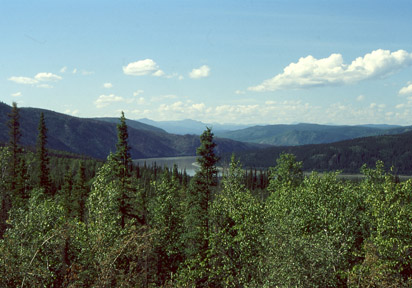
Yukon River at Dalton Hwy., Alaska (c) 2005 Scott and Ruth Bassett
Bioimages home (click on an image to enlarge)
view
this page in its intended navigation context
Interior Alaska-Yukon lowland taiga
(WWF
ecoregion NA0607)

Yukon River at Dalton Hwy., Alaska
(c)
2005 Scott and
Ruth Bassett

Source of bioregions data:
Olson, D. M. and
E. Dinerstein. The Global 200: Priority ecoregions for global conservation. (PDF
file) Annals of the Missouri Botanical Garden 89:125-126.
Distinctiveness (1=highest,4=lowest): 3 (bioregionally
outstanding)
This ecoregion is predominated by spruce coniferous forests and has retained
intact ecosystems, including healthy populations of top predators.*
Conservation Status (1=most endangered, 5=most
intact): 5 (relatively intact)
There is little habitat loss or fragmentation.*
 Picea glauca (white spruce)
Picea glauca (white spruce) Picea mariana (black spruce)
Picea mariana (black spruce)
 Populus tremuloides (quaking aspen)
Populus tremuloides (quaking aspen)
Some views from the ecoregion
Taiga, foothills south of the Brooks Range, Alaska



(c)
2005 Scott and
Ruth Bassett
hires
hires
hires
Taiga, Yukon River crossing, Dalton Hwy., Alaska

(c)
2005 Scott and
Ruth Bassett
hires
Taiga, central Alaska


(c) 2005
Natasha Sherman
hires
hires
* Ricketts, T.H., E. Dinerstein, D.M. Olson, C.J. Loucks, et al. (1999) Terrestrial Ecoregions of North America: A Conservation Assessment. World Wildlife Fund - United States and Canada. Island Press, Washington, D.C. pp. 337-340.
Except as noted, images copyright 2002-2005 Steve Baskauf - Terms of use